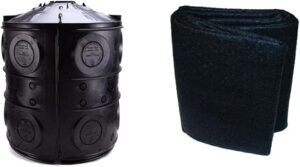Effective Drainage Solutions for Waterlogged Gardens: Keep Your Backyard Blooming, Not Flooded!
If you’re looking for effective drainage solutions for waterlogged gardens, this post is for you. Once, I spent weeks planting my dream garden. The flowers are blooming, my tomatoes are growing, and the mulch smells fresh. Then—bam! A heavy downpour hits, and suddenly my beautiful garden looks more like a swamp. It would happen to you also. Waterlogged gardens are a common frustration for gardeners across the U.S., especially in areas prone to heavy rain or clay-rich soil. But don’t worry, effective drainage solutions for waterlogged gardens can save your plants, lawn, and sanity. In this blog, we will explore why your garden might be turning into a soggy mess and how to fix it with practical, proven solutions complete with top-rated Amazon affiliate product recommendations to help you get the job done right.
Why Gardens Become Waterlogged
Before we fix the problem, let’s understand it.
1. Poor Soil Drainage
Clay-heavy soils are notorious for holding onto water. If your soil feels sticky and clumpy, it likely has poor drainage.
2. Compacted Soil
Walking or working in your garden too often can compress the soil, making it hard for water to pass through.
3. High Water Table / Heavy Rainfall
Live in a rainy region like the Pacific Northwest? Your water table might be too high for proper drainage.
4. Improper Landscaping
Flat yards or poorly designed slopes can cause water to collect in low spots.
Signs Your Garden Has Drainage Issues
Watch out for these red flags:
- Standing water for hours or days after rain
- Yellowing leaves or stunted plant growth
- Mushy, soft ground
- Bad odors from soggy soil (a sign of root rot)
If you notice these, it’s time to take action.
Top 7 Effective Drainage Solutions for Waterlogged Gardens
Let’s get to the good stuff—fixes that work.
1. Install a French Drain
A French drain redirects water away from your garden using a perforated pipe buried in gravel.
Editor Recommendation:
NDS 4-in. x 10-ft. Prefabricated French Drain with Pipe – This all-in-one kit is easy to install and perfect for backyard DIYers.

I installed this in my sloped backyard in Georgia, and within a week, the swampy corner was dry and usable. My hydrangeas have never looked better!
2. Use a Dry Well
A dry well collects and disperses excess water underground.
Editor Recommendation:
StormTrap Dry Well Kit – Great for large gardens with heavy runoff.

3. Build Raised Garden Beds
Elevate your plants above soggy soil to improve root health.
Editor Pick:
Vita Raised Garden Bed (4×4 ft) – Durable, easy to assemble, and weather-resistant.

After my first raised bed experiment, I harvested more lettuce than ever before—even after a stormy spring in Ohio!
4. Amend the Soil
Mix in organic matter like compost or sand to improve drainage.
Editor Pick:
FoxFarm Happy Frog Soil Conditioner – Rich in microbes and nutrients, perfect for soil rehab.

5. Extend Your Gutters
Sometimes the problem starts with your roof. Make sure downspouts don’t flood your garden.
Best Buy:
Flex-Drain Downspout Extension – Flexible and expandable, directs water where you want it.

6. Create Permeable Pathways
Hard surfaces like concrete trap water. Use gravel or pavers instead.
Editor Recommendation:
TRUEGRID Paver Grid System – Eco-friendly and supports foot traffic.

7. Install a Sump Pump (For Severe Cases)
If your yard regularly floods, a sump pump may be necessary.
Editor Pick:
WAYNE Water Removal Pump – Fast, reliable, and ideal for emergency water removal.

DIY vs. Professional Help: What’s Best?
Go DIY if:
- You have basic tools and time
- The problem is localized
Hire a Pro if:
- There’s major erosion
- You’re dealing with underground utilities
- Water is pooling near your home’s foundation
A certified landscaper can assess the issue and help design a long-term solution.
Maintaining Your Garden After Fixing Drainage
Once you’ve solved the drainage problem, keep your garden healthy with these tips:
- Mulch your beds to prevent erosion
- Choose water-tolerant plants for low areas
- Test your soil annually
- Avoid compacting soil by using stepping stones
Don’t Let Water Wash Away Your Hard Work
Waterlogged gardens are every gardener’s nightmare—but they don’t have to be permanent. With these effective drainage solutions for waterlogged gardens, you can reclaim your yard, protect your plants, and enjoy gardening again, rain or shine.
And remember, the right tools make all the difference. Whether it’s a French drain kit, raised garden bed, or soil conditioner, we’ve linked the best Amazon products to help you succeed. Happy gardening!
“To plant a garden is to believe in tomorrow.” – Audrey Hepburn
Quick Product Recap (With Affiliate Links)
| Solution | Product | Link |
|---|---|---|
| French Drain | NDS French Drain Kit | Buy on Amazon |
| Dry Well | StormTrap Dry Well Kit | Buy on Amazon |
| Raised Beds | Vita Raised Bed | Buy on Amazon |
| Soil Amendment | FoxFarm Conditioner | Buy on Amazon |
| Gutter Extension | Flex-Drain Extension | Buy on Amazon |
| Pathway Grid | TRUEGRID System | Buy on Amazon |
| Sump Pump | WAYNE Pump | Buy on Amazon |









